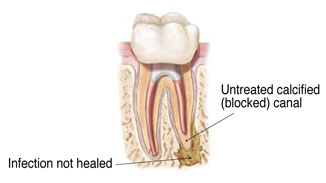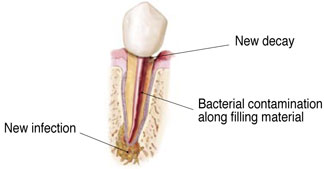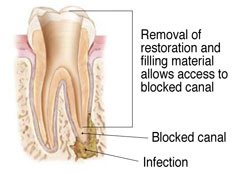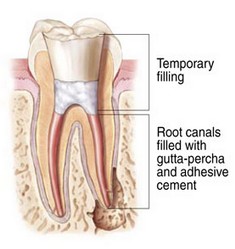ROOT CANAL RETREATMENT

Occasionally root canal treatment is unsuccessful for a variety of reasons. Part of an endodontist's evaluation is to identify the specific sources of a dental problem and to assess whether or not they will be able to correct it. A 3 dimensional image, or CBCT scan, is extremely useful in assessing teeth with previous endodontic treatment. A common cause for failure of root canal treatment is when all canals were not identified and treated, or if canals were not thoroughly cleaned. Often these types of issues are correctable with proper retreatment.

Leakage of salivary bacteria can also cause root canal treatment to become contaminated, resulting in infection of the root canals and eventually the surrounding bone or gums. This leakage can occur through a poorly-fitting crown or filling, or through an area of new decay. Contamination of a poorly-sealed root canal occurs rapidly. This is in contrast to a well-sealed root canal, which slows or prevent contamination and infection from occurring. This type of issue can also usually be corrected with retreatment.
The objectives of retreatment are the same as with initial root canal treatment. They are to:
1 - Mechanically remove debris, tissue and infection from within the canal spaces.
2 - Chemically disinfect the spaces and return them to a sterile state.
3 - Seal off the spaces within the tooth with a root canal filling so that recontamination does not occur.

Before this can be done, the existing restoration and previous root canal treatment needs to be "disassembled". This might include removing or making an access opening through an existing crown, or removing exisiting posts and / or cores. Once the disassembly is done, the previous root canal filling material is removed, so all canal spaces can be cleaned and disinfected. Occasionally the canals will be filled with a temporary medication for a period of time before the treatment is completed at a separate visit.

The final step of retreatment is sealing the canals with a root filling. When the retreatment is completed, you will need to return to your restorative dentist after a period of healing to have the tooth permanently restored. If the previous restoration is damaged or leaking, it will need to be replaced. A well-fitting final restoration is essential for the success of root canal treatment.
